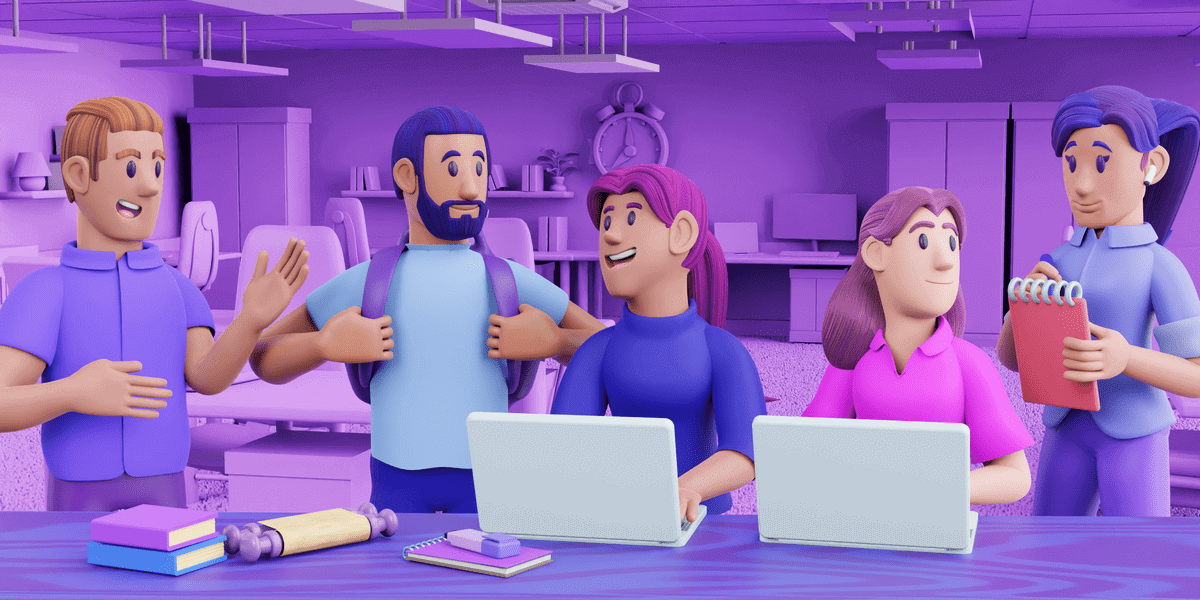A colaboração vem em muitas formas e formatos. Determinada por um grande número de fatores formais, organizacionais ou estilísticos, podemos identificar muitos tipos diferentes de colaboração em equipe. Todos esses tipos têm suas características distintas que desempenham um papel no curso do projeto e na qualidade da colaboração em si.
Nas linhas a seguir, usaremos uma variedade de critérios para reconhecer diferentes tipos de colaboração em equipe e focar em como suas particularidades impactam a natureza da parceria profissional.

Critérios de classificação
Existem muitas maneiras diferentes de abordar a categorização de colaborações de equipe. Como não estamos focando em um aspecto particular da colaboração de equipe, mas observando o campo como um todo, faremos o nosso melhor para cobrir uma ampla gama de critérios para identificar algumas das configurações de colaboração mais comuns, tanto em termos de sua estrutura formal quanto de suas características estilísticas.
Os critérios de escopo
Embora o foco principal deste artigo (e da biblioteca de conhecimento de colaboração como um todo) seja a colaboração em nível de equipe, é importante identificar outros modelos de colaboração que estejam fora dos limites organizacionais internos. Em termos de escopo e alcance, podemos identificar três principais tipos de colaboração:
- Colaboração em equipe
- Colaboração na comunidade
- Colaboração em rede
Colaboração em equipe
Como nos concentraremos mais neste modelo de colaboração nas linhas a seguir, usaremos este espaço para simplesmente observar as principais características deste tipo de colaboração que o separam dos outros.
A colaboração em equipe é marcada por participantes definidos e seus papéis, uma divisão relativamente clara de tarefas interdependentes, expectativas de reciprocidade e metas e cronogramas explicitamente declarados. Membros cumprem suas tarefas individuais para atingir seus objetivos compartilhados. O grau de hierarquia estruturada e liderança na colaboração em equipe pode variar, mas os participantes geralmente operam no princípio da igualdade, tanto em suas operações do dia a dia quanto no reconhecimento de suas realizações coletivas. A colaboração em equipe também pode ocorrer em um nível interorganizacional, onde membros de diferentes entidades profissionais formam uma equipe unida, mas este modelo de colaboração também é definido pelas características acima mencionadas de uma associação estruturada, papéis definidos e metas e cronogramas compartilhados.
Colaboração na comunidade
Este modelo difere da colaboração em equipe em sua mudança de foco de conquistas para compartilhamento de conhecimento. A colaboração comunitária gira em torno de uma área de interesse compartilhada, onde os membros da comunidade profissional circundante buscam ajuda de seus pares para superar desafios, fornecem conselhos e trabalham juntos em tarefas e projetos não relacionados às tarefas e projetos da organização- matriz dos participantes. A associação neste tipo de colaboração é mais comumente fluida e indefinida, embora haja exceções em que a colaboração é mais definida e estruturada. Um exemplo óbvio deste tipo de colaboração é a Wikipédia, onde os membros da comunidade contribuem com sua expertise para sua área de interesse escolhida.
Colaboração em rede
Este tipo de colaboração também envolve as contribuições de membros individuais de uma comunidade profissional. A principal diferença entre colaboração em rede e colaboração comunitária é que a última é focada em beneficiar a comunidade, enquanto a primeira é focada principalmente nos objetivos dos participantes individuais que também fornecem valor à comunidade.
Uma rede colaborativa é definida como uma parceria entre indivíduos autônomos e organizações que compartilham conhecimento e recursos suportados por uma rede de computadores. Os participantes são geograficamente deslocados e as colaborações abrangem partes de diferentes indústrias ou comunidades profissionais globais inteiras. Os participantes trabalham para a realização de seus objetivos individuais, mas compartilham os dados e recursos que implementam e geram em seu trabalho.
Dependendo das áreas profissionais específicas, existem vários modelos de parcerias de rede que diferem significativamente em termos de escopo, objetivos e arranjos específicos.
Os critérios de canais de comunicação
Com base no modo principal de comunicação entre seus participantes, a colaboração em equipe pode ser realizada digitalmente ou presencialmente. Esses dois tipos de colaboração não são uma proposta de "ou este, -ou aquele", pois podem ser utilizados de forma intercambiável, dependendo da configuração específica da equipe.
Colaboração digital
Os avanços tecnológicos das últimas duas décadas inauguraram uma nova era de colaboração de equipes distribuídas e abriram caminho para a crescente onda de trabalho remoto. A colaboração digital é uma forma de parceria profissional conduzida por meios e canais digitais de comunicação. Ela permite que colaboradores de diferentes localizações geográficas se comuniquem e cooperem tanto em tempo real quanto de forma assíncrona.
É seguro dizer que a maioria das organizações profissionais contemporâneas depende da colaboração digital de alguma forma e capacidade. Os benefícios da colaboração digital não se refletem apenas na conectividade de participantes fisicamente deslocados, mas em vários outros aspectos: a facilidade de armazenar informações e sua acessibilidade, sincronização com uma ampla gama de ferramentas digitais que permite maior coordenação e eficiência, a conveniência de compartilhamento de conhecimento e recursos, menores custos operacionais e assim por diante.
Colaboração presencial
A maneira "tradicional" de colaborar pessoalmente se perdeu na sombra da colaboração remota nos últimos anos, mas ainda tem grande importância e traz uma série de benefícios exclusivos. A colaboração presencial é condicionada pela localização compartilhada de seus participantes, que se comunicam diretamente entre si para compartilhar suas experiências e pensamentos em direção à realização de um objetivo comum.
A colaboração presencial ocorre de várias maneiras formais ou informais, desde a comunicação imediata entre seus participantes, reuniões organizadas, workshops e sessões de geração de ideias. Enquanto a colaboração digital é mais adequada para a comunicação contínua relacionada ao trabalho, pois é gravada e acessível, a colaboração presencial é mais adequada para situações complexas que exigem uma discussão mais ampla e envolvem um grande número de participantes, onde um consenso pode ser alcançado em um período de tempo relativamente curto, particularmente em comparação com o cenário temido de longas e exaustivas sequências de e-mail que podem ser bastante ineficazes e difíceis de navegar.
Os critérios de sincronicidade
A colaboração pode ocorrer em tempo real, onde os participantes estão simultaneamente envolvidos em uma tarefa compartilhada, ou pode acontecer de forma deslocada no tempo. Por esse critério, identificamos dois modelos de colaboração: síncrona e assíncrona.
Colaboração síncrona
Este tipo de colaboração requer que os participantes trabalhem juntos e ao mesmo tempo. A comunicação é imediata com uma troca contínua de conhecimento e informação. Este tipo de colaboração não é determinada pela localização, pois pode ocorrer pessoalmente, mas também pode ser conduzida por outros meios de comunicação, como uma videochamada ou um chat.
Como a colaboração síncrona é eficiente em termos de tempo, ela é mais adequada para situações que exigem uma resposta imediata, discussão e alinhamento rápido. No entanto, ela não é ideal para nenhuma situação colaborativa, particularmente situações que exigem um esforço individual concentrado e independente, onde tentativas de comunicação de outros participantes podem distrair do trabalho em questão. Tais situações são melhor resolvidas com um agendamento sólido e criando intervalos de tempo específicos para colaboração síncrona.
Colaboração assíncrona
Neste tipo de colaboração, os participantes não precisam se envolver imediatamente na comunicação. Embora as informações de seus colaboradores cheguem aos participantes instantaneamente, eles podem escolher quando responder. Exemplos comuns de colaboração assíncrona são e-mails, documentos compartilhados interativos, atualizações de status, etc.
A colaboração assíncrona é mais adequada para trabalho contínuo que não requer atenção imediata de ninguém, bem como discussões contínuas que exigem mais tempo e preparação dos participantes. Este tipo de colaboração também é adequada para equipes com membros espalhados por diferentes fusos horários.
Os critérios de localização
Embora equipes profissionais tradicionalmente compartilhem o mesmo espaço físico, nos últimos anos isso tem se tornado cada vez mais uma opção em vez de um fato. Com base nos critérios de localização, podemos identificar tipos de colaboração co-localizados e remotos. Em termos de suas características definidoras, essa divisão corre quase paralela à dicotomia digital/presencial, com a principal diferença sendo que a colaboração remota depende exclusivamente de meios digitais de comunicação.
Colaboração colocalizada
Esse tipo de colaboração acontece em um espaço físico compartilhado (por exemplo, um escritório). Os membros da equipe trabalham em proximidade física e conseguem se comunicar de forma direta e imediata. Além das características já mencionadas com a colaboração presencial, a qualidade distintiva da colaboração co-localizada é o potencial de desenvolver fortes relacionamentos interpessoais, o que leva a um nível mais alto de entendimento entre os participantes, bem como a um grau mais alto de motivação para o sucesso de seus esforços conjuntos.
Colaboração remota
A colaboração remota ocorre entre equipes distribuídas, onde os membros operam de diferentes locais, com ferramentas digitais como seu único meio de comunicação. Já descrevemos como a colaboração digital impacta a parceria profissional, então vamos nos concentrar nas especificidades da experiência remota.
A coordenação é o aspecto crucial da colaboração remota, onde os membros geralmente estão espalhados por diferentes locais, fusos horários e até mesmo culturas. Alcançar o alinhamento entre os membros da equipe remota é a prioridade absoluta, e é alcançado por meio de comunicação, transparente, planejamento inteligente, reuniões regulares e discussão ativa entre os participantes, com respeito ao horário de trabalho de todos e outras circunstâncias únicas.
Os critérios de organização
A colaboração em equipe nem sempre é configurada em torno de uma equipe estruturada com funções fixas e metas definidas de curto e longo prazo. Situações profissionais específicas geralmente exigem agrupamentos exclusivos de participantes individuais para cumprir uma variedade de objetivos diferentes. Com base nesses critérios, nós identificamos três tipos principais de colaboração: estática, ad-hoc e aberta.
Colaboração estática
Este tipo de colaboração descreve a estrutura tradicional da equipe. É caracterizada por processos de longo prazo definidos e repetitivos (ou seja, tarefas) realizados por participantes com funções atribuídas. Este tipo de colaboração é mais adequada para cenários profissionais previsíveis, onde as atividades são planejadas e executadas com uma perspectiva de longo prazo baseada em estabilidade relativa e sem grande necessidade de flexibilidade e adaptabilidade.
Colaboração ad-hoc
O termo latino “ad-hoc” se traduz como “para esse propósito”, significando que essa abordagem é utilizada quando necessária, para um propósito ou necessidade específica. Esse tipo de colaboração ocorre em situações e ambientes profissionais altamente dinâmicos, onde tarefas e objetivos mudam com o tempo ou sua complexidade requer recursos adicionais. As tarefas e operações que são objeto de colaboração ad-hoc geralmente ocorrem apenas uma vez e não são repetitivas.
As colaborações ad-hoc são distribuídas por natureza, envolvendo participantes de diferentes divisões organizacionais ou mesmo diferentes organizações. Essas colaborações são estabelecidas para responder a desafios específicos e, mais comumente, se dissolvem quando esses desafios são suficientemente abordados.
Colaboração aberta
As colaborações abertas são semelhantes à colaboração comunitária mencionada anteriormente. Nesse tipo de colaboração, a tarefa não é atribuída especificamente a nenhum indivíduo ou entidade, com os participantes contribuindo livremente para o interesse compartilhado. Pode haver vários graus de coordenação entre os colaboradores, de nenhum a uma abordagem mais estruturada e definida. A supervisão do trabalho também pode ser distribuída ou centralizada, com a qualidade controlada pelo próprio sistema, uma entidade designada ou o feedback da comunidade. Esse tipo de colaboração é mais adequada para trabalho de longo prazo sem objetivos definidos, sem restrições de tempo ou qualidade e uma necessidade destacada de uma sabedoria distribuída e diversificada.
Os critérios de estilo
A colaboração em equipe é frequentemente definida pelas características individuais dos participantes que formam uma qualidade coletiva agregada. Todos os participantes assumem um certo papel na equipe, e a divisão e a distribuição dos papéis da equipe determinam as características coletivas da equipe como um todo.
Dessa perspectiva, podemos identificar seis estilos colaborativos diferentes em um ambiente de equipe: estilo divisível, aditivo, compensatório, disjuntivo, conjuntivo e discricionário. É importante observar que, na prática, as equipes não estão restritas a um único estilo de colaboração e podem modificar sua abordagem para melhor lidar com a tarefa específica em questão.
Estilo divisível de colaboração
Este tipo de colaboração ocorre em um ambiente profissional onde as tarefas podem ser divididas entre os membros da equipe e então integradas em um corpo coletivo de trabalho. O estilo divisível é marcado por um menor grau de colaboração ativa entre os membros da equipe, em vez de depender da natureza definida do trabalho e de uma divisão enfatizada de papéis e responsabilidades. Esta abordagem permite que os participantes empreguem seu conjunto de habilidades independentemente uns dos outros e depende de um alto nível de coordenação para atingir o objetivo coletivo.
Estilo aditivo de colaboração
Este estilo de colaboração funciona como a imagem espelhada do estilo divisível. Em vez do trabalho coletivo ser dividido entre os participantes, os esforços individuais independentes dos membros da equipe se somam para formar um corpo de trabalho voltado para a realização de um objetivo compartilhado. Os resultados esperados são definidos, mas o trabalho em si não é definido e previsível a ponto de poder ser dividido com antecedência. Este estilo permite que os participantes moldem o curso do projeto por meio de suas contribuições e qualidades únicas.
Estilo compensatório de colaboração
Este tipo de colaboração é utilizado em situações que exigem múltiplas perspectivas e expertise para produzir os resultados desejados. Este modelo é determinado pelas qualidades multidisciplinares de seus membros, onde os membros da equipe com conjuntos de habilidades únicas “compensam” a falta de expertise em uma determinada área fornecendo suas contribuições relevantes. Em tais equipes, os membros não são intercambiáveis, pois todos desempenham papéis específicos e “preenchem” lacunas específicas que não podem ser abordadas pelos conjuntos de habilidades de outros membros.
Estilo disjuntivo de colaboração
À primeira vista, esse estilo de colaboração parece o oposto da colaboração, pois não foca na força da equipe, mas em seu elo mais forte. Pode ser difícil imaginar um cenário colaborativo girando em torno de um indivíduo, mas há cenários profissionais que exigem uma abordagem "todos por um". Como exemplo, vamos imaginar um membro da equipe se apresentando em um evento do setor, e outros membros da equipe reunindo seus recursos para ajudá-lo a se preparar – seja por meio de pesquisa, feedback, incentivo e outras formas de assistência.
Estilo conjuntivo de colaboração
O oposto do estilo disjuntivo, a abordagem conjuntiva à colaboração foca na força da equipe como um todo e nas contribuições individuais de todos. Esse tipo de colaboração é marcado por um alto grau de interdependência entre o trabalho dos membros da equipe, onde cada contribuição individual representa uma peça do quebra-cabeça necessária para o sucesso do projeto.
Estilo discricionário de colaboração
Esta abordagem de colaboração é marcada por um alto grau de auto-organização dentro de uma equipe. Em vez de seguir um modelo fixo de divisão de papéis e tarefas repetitivas, os membros da equipe escolhem como abordar qualquer tarefa dada, dependendo de suas circunstâncias específicas. Esta abordagem não tem métodos distintos de conclusão de tarefas e não exclui nenhum dos estilos mencionados anteriormente, mas, em vez disso, utiliza qualquer um deles que a equipe sinta que melhor se adapta ao trabalho específico em questão.
Liberte a colaboração eficaz com o Pumble
A colaboração é um conceito fluido que não precisa ser restringido por um conjunto fixo de métodos. Nosso trabalho nos expõe a uma variedade de cenários profissionais, e não podemos lidar com todos eles com a mesma abordagem predefinida. Isso exige uma mentalidade flexível e uma abertura para explorar diferentes caminhos de colaboração.
Entre no Pumble, um aplicativo de comunicação de equipe.
Com seus recursos versáteis projetados para agilizar a comunicação e aprimorar o trabalho em equipe, o Pumble oferece uma solução adaptada às necessidades exclusivas da colaboração moderna.
Seja por mensagens diretas, compartilhamento de arquivos, ou videochamadas, o Pumble fornece as ferramentas necessárias para promover uma colaboração eficaz entre equipes e projetos.
Com uma compreensão mais profunda das características distintas de vários tipos de colaboração e dos benefícios adicionais que plataformas como o Pumble trazem para a mesa, as equipes podem adaptar suas estratégias para atender às demandas de qualquer cenário profissional.
Eleve os esforços colaborativos da sua equipe com o Pumble.
Como avaliamos esta publicação: Nossos escritores e editores monitoram as postagens e as atualizam quando novas informações ficam disponíveis, para mantê-las atualizadas e relevantes.


